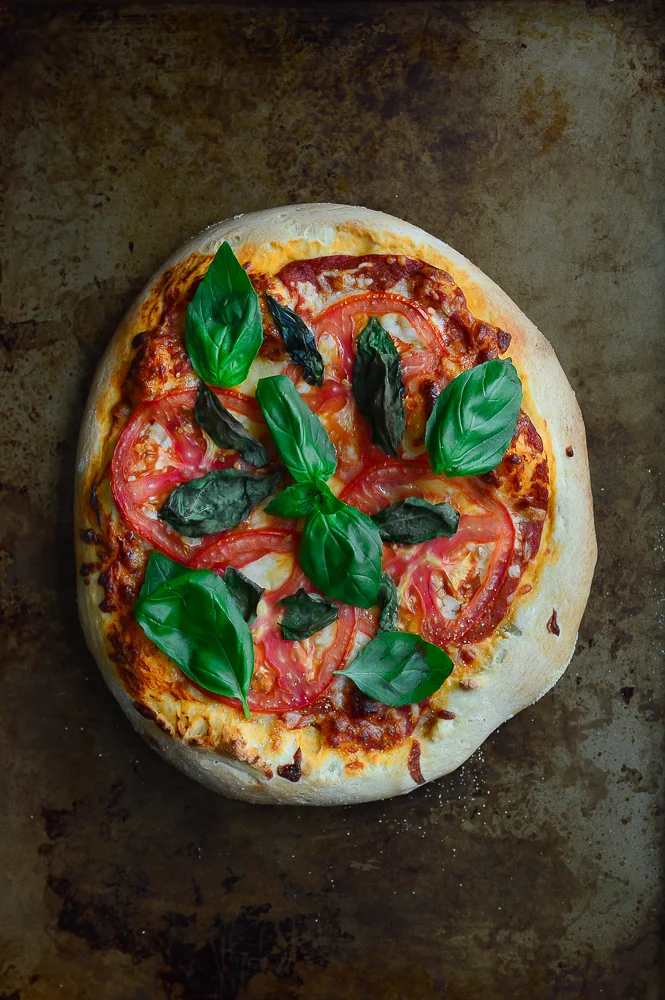Pizza, pizza, pizza. One of my favorite foods which I’m sometimes reluctant to make at home because it’s hard finding a crust recipe that I liked. But I finally landed on this one by the near-mythical Mark Bittman. As Bittman advises in How to Cook Everything, swapping out a half cup of flour for a half cup of cornmeal gives the crust a pleasant crunch. A generous medley of fresh sage, thyme, and rosemary gives this pizza an extraordinary flavor (though the pancetta and butter-sautéd mushrooms also help!). I modified the pizza dough recipe slightly by incorporating the herbs into the dough itself and drizzling a little extra olive oil onto the dough before it rises to produce a supple pizza crust. This recipe yields two personal pan pizzas so I suggest doubling or even tripling it for larger parties.
*For the pizza dough:
2 ½ cups all-purpose or bread flour
½ cup cornmeal, plus more for dusting
2 tsp rapid rise yeast
2 tsp kosher or sea salt
1 tbsp fresh sage, thyme & rosemary, finely-minced
1 cup water
2 tbsp olive oil
For the pizza topping:
4 oz pancetta, finely-diced
8 oz shitake or baby bella mushrooms, roughly chopped
1 tbsp fresh sage, thyme & rosemary, finely-minced
3 cloves garlic, minced
1 shallot, minced
1 cup creme fraiche
2 tbsp butter
1 splash of apple cider vinegar
Salt and pepper
Combine the flour, cornmeal, 1 tbsp herbs, yeast and salt in a food processor. Turn it on and add the olive oil and 1 cup of water through the tube. Once the mixture has formed a ball, about 30 seconds later, turn off the food processor and remove the lid. The dough should be slightly sticky but if it feels to try, turn on the machine again and add a small drizzle of olive oil through the feed tube and process for about 10 more seconds.
Dust your work surface with cornmeal. Turn out the dough and kneed with your hands for about 10 seconds until smooth. Form it into a ball. Place the dough into a medium-sized bowl and drizzle with a tiny bit of olive oil, enough to cover the dough evenly but you should avoid having a puddle of oil in the bowl. Cover with plastic wrap, allow to rise for 1-2 hours.
Meanwhile, make the topping. Melt 1 tbsp butter in a saucepan over medium-high heat and add the shallot and garlic. Sauté for several minutes until translucent, then add the remaining 1 tbsp butter and the mushrooms, pancetta, and 1 tbsp fresh herbs. Cook for several more minutes until the mushrooms are slightly soft and the pancetta has browned slightly, then add a small splash of apple cider vinegar. Keep stirring until the fragrance of the vinegar as dissipated. Turn off the heat and set aside. Sop up a bit of the oil by placing the mixture on a small bed of paper towels.
Turn on your oven to its highest possible bake setting, about 500-550 degrees Fahrenheit (if your home oven has the capacity to reach 600-700 degrees, then lucky you!)
When the dough has finished rising, turn it out onto a cornmeal-dusted work surface, divide it in half, and form each half into a ball. Like in Step 1, coat each ball of dough with a tiny bit of olive oil and cover them with a paper towel. Let them rise of 20 minutes.
Dust a pizza peel with a little cornmeal. Kneed one ball of dough with your hands to evenly distribute the coating of olive oil, and once it is has become silky smooth to the touch, roll it out into a rough rectangle, about 6”x10”. Spoon half of crème fraîche on the dough and spread it around in an even, thin layer. Sprinkle on half of the topping and slide the pizza onto a baking stone in the oven. Bake for 10-12 minutes until the crust has become golden brown, but as a precaution, check the pizza after eight minutes to make sure it’s not burning. Repeat Step 6 with the second ball of dough and the remaining half of the toppings.
*Credit for the pizza dough goes to Mark Bittman’s How to Cook Everything.
If you make this recipe, snap a photo and share it on social media and tag #spiceandhutch. I would love to see your culinary creations!





